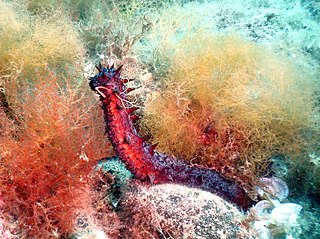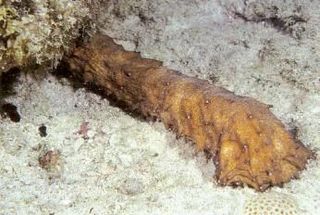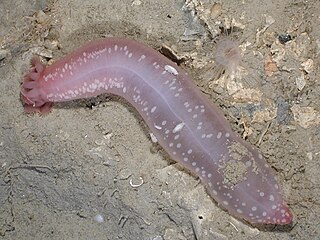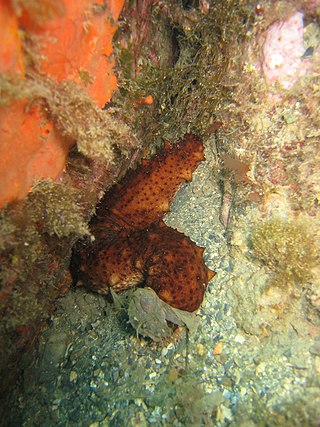
Sea cucumbers are echinoderms from the class Holothuroidea. They are marine animals with a leathery skin and an elongated body containing a single, branched gonad. Sea cucumbers are found on the sea floor worldwide. The number of known holothurian species worldwide is about 1,786, with the greatest number being in the Asia-Pacific region. Many of these are gathered for human consumption and some species are cultivated in aquaculture systems. The harvested product is variously referred to as trepang, namako, bêche-de-mer, or balate. Sea cucumbers serve a useful role in the marine ecosystem as they help recycle nutrients, breaking down detritus and other organic matter, after which bacteria can continue the decomposition process.

Sea cucumbers are marine animals of the class Holothuroidea. They can be used as food, in fresh or dried form, in various cuisines. In some cultural contexts the sea cucumber is thought to have medicinal value.
Evisceration is a method of autotomy involving the ejection of internal organs used by animals as a defensive strategy. Sea cucumbers (Holothuroidea) eject parts of the gut in order to scare and defend against potential predators such as crabs and fish. The organs are regenerated in a few days by cells in the interior of the sea cucumber.

Isostichopus fuscus, commonly known as the brown sea cucumber, is a species of sea cucumber in the family Stichopodidae native to the eastern Pacific. It was first described to science by German biologist Hubert Ludwig in 1875.

Holothuria atra, commonly known as the black sea cucumber or lollyfish, is a species of marine invertebrate in the family Holothuriidae. It was placed in the subgenus Halodeima by Pearson in 1914, making its full scientific name Holothuria (Halodeima) atra. It is the type species of the subgenus.

Holothuria scabra, or sandfish, is a species of sea cucumber in the family Holothuriidae. It was placed in the subgenus Metriatyla by Rowe in 1969 and is the type species of the subgenus. Sandfish are harvested and processed into "beche-de-mer" and eaten in China and other Pacific coastal communities.

Holothuria tubulosa, the cotton-spinner or tubular sea cucumber, is a species of sea cucumber in the family Holothuriidae. It is the type species of the genus Holothuria and is placed in the subgenus Holothuria, making its full name Holothuria (Holothuria) tubulosa.

Holothuria thomasi, the tiger's tail, is a species of sea cucumber in the family Holothuriidae. Although it is the largest sea cucumber known in the western Atlantic Ocean, it is so well camouflaged that it was 1980 before it was first described. It is placed in the subgenus Thymiosycia making its full name Holothuria (Thymiosycia) thomasi.

Colochirus robustus, commonly known as the robust sea cucumber or the yellow sea cucumber, is a species of sea cucumber in the family Cucumariidae. It is found in shallow seas in tropical parts of the central Indo-Pacific region. C. robustus belongs to the class Holothuroidea, a group of echinoderms called sea cucumbers and known for unusual behavior including evisceration, asexual reproduction, and regeneration. The robust sea cucumber has a soft body and lacks a spine, but it does have an endoskeleton consisting of microscopic spicules, or ossicles, made of calcium carbonate. C. robustus has a respiratory tree that allows it to extract oxygen for respiration, using the anus to pump water. The robust sea cucumber is an important dietary staple for many East and Southeast Asian populations, and has been used for medicinal purposes for hundreds of years. Recent research suggests that peptides from C. robustus enhance the activity of the immune system.

Holothuria parvula, the golden sea cucumber, is a species of echinoderm in the class Holothuroidea. It was first described by Emil Selenka in 1867 and has since been placed in the subgenus Platyperona, making its full scientific name Holothuria (Platyperona) parvula. It is found in shallow areas of the Caribbean Sea and Gulf of Mexico and is unusual among sea cucumbers in that it can reproduce by breaking in half.

Holothuria leucospilota, commonly known as the black sea cucumber or black tarzan, is a species of marine invertebrate in the family Holothuriidae. It is placed in the subgenus Mertensiothuria making its full scientific name Holothuria (Mertensiothuria) leucospilota. It is the type species of the subgenus and is found on the seabed in shallow water in the Indo-Pacific.

Chiridotidae is a family of sea cucumbers found in the order Apodida. Within the family, there are 16 recognized genera all with different ranges of body types and functions. Sea cucumbers play a fundamental role in many marine ecosystems.
Holothuria grisea, the gray sea cucumber, is a mid-sized coastal species of sea cucumber found in shallow tropical waters of the Atlantic Ocean from Florida to Southern Brazil and West Africa. They have a variety in color and can range from red to more yellowish with brown markings. They are also a food source for local and international markets with the majority of harvesting taking place in Brazil. This species is currently not over-fished and is not endangered or threatened.

Holothuria (Microthele) nobilis, the black teatfish, is a species of sea cucumber in the genus Holothuria. The cucumber is found in the tropical waters of the Indo-pacific ocean. It was first described by Emil Selenka in 1867.

Actinopyga varians, the Pacific white-spotted sea cucumber or Hawaiian sea cucumber, is a species of sea cucumber in the family Holothuriidae. It is found in the Pacific Ocean near Hawaii and also in the Indo-Pacific Ocean.

Holothuria (Platyperona) difficilis is a species of sea cucumber in the family Holothuriidae. Holothuria comes from Latin but is originally taken from Greek. Its meaning is a plantlike animal whose origin is uncertain.

Holothuria pervicax is a species of sea cucumber in the genus Holothuria. It is commonly called the stubborn sea cucumber due to its inability to be kept alive in captivity. It is commonly found buried beneath rocks on reefs in warm waters.

Holothuria stellati, also known as the brown sea cucumber,is a species of sea cucumber in the family Holothuriidae. First described by Delle Chiaje in 1824. There are two accepted subspecies, Holothuria stellatidakarensis and Holothuria stellati mammata, though there is still debate on whether or not they are separate species.
Holothuria (Cystipus) cubana is a species of sea cucumber in the family Holothuriidae. This species was first described by Ludwig in 1875.

















